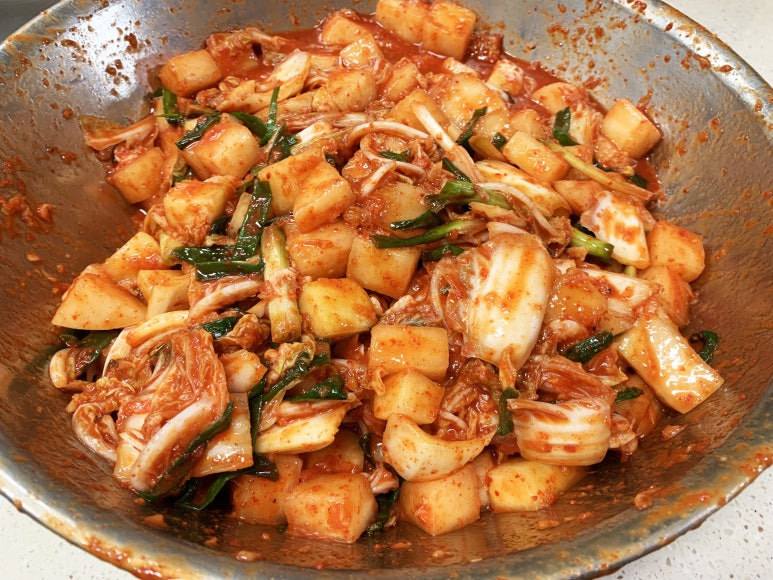Seoul-Style Kkakdugi: The Essence of a Clear and Refreshing Broth
#RadishDish #CabbageDish #HowToMakeSeoulStyleKkakdugi #KkakdugiForGukbap #CopycatHadonggwanKkakdugi #HomemadeKkakdugi

Let’s recreate the iconic kkakdugi from Hadonggwan, a beloved gomtang (beef bone soup) restaurant in Seoul with 70 years of history! Seoul-style kkakdugi features crisp radish and tender cabbage, seasoned purely with salted shrimp (saeujeot) for a clean, refreshing taste. It’s not spicy or salty, but has a subtle sweetness and a delightful broth, perfect for accompanying a hearty meal, especially in winter. It’s so good, you’ll easily finish a bowl of rice and a bowl of soup! Shall we get started on making this delicious Seoul-style kkakdugi? ^^
Main Ingredients- 4 large radishes
- 4 small napa cabbages (al-baechu)
- 300g Korean leek (jjokpa)
Cooking Instructions
Step 1
First, let’s make the glutinous rice paste. In a pot, combine water and 2 ‘Hanal Broth’ cubes and bring to a boil. Gradually whisk in glutinous rice flour until smooth and thickened. Once it reaches a thick consistency, remove from heat and let it cool completely. This step infuses a deep savory flavor from the broth.

Step 2
Once the rice paste is completely cooled, add the gochugaru (Korean chili flakes) and mix well. Adding gochugaru to the cooled paste first allows it to absorb moisture, creating a smooth and thick base for the seasoning.

Step 3
After thoroughly mixing the gochugaru and rice paste, refrigerate it for a while to let it mature. This resting period will make the chili paste smoother and more refined, resulting in a delicious seasoning base.

Step 4
While the seasoning is resting, let’s prepare the main ingredients. Cut the al-baechu (small napa cabbage) into bite-sized, large pieces.

Step 5
Wash the radishes, peel them, and cut them into large cubes. You can adjust the size of the cubes to your preference.

Step 6
Korean leek (jjokpa) is another key ingredient in Seoul-style kkakdugi. Wash the leeks thoroughly, trim the roots, and cut them into lengths similar to the radish cubes. If you can’t find jjokpa, you can substitute it with chives for a different flavor profile.

Step 7
Now, it’s time to salt the vegetables. Place the cubed radish in a bowl, add 2 Tbsp of coarse sea salt and 1 Tbsp of sugar, along with a little water. Mix well and let it salt for about 20-30 minutes until softened.

Step 8
Repeat the salting process for the cabbage. In a separate bowl, combine the cabbage with 2 Tbsp of coarse sea salt and 1 Tbsp of sugar. Add a little water, mix well, and let it wilt for 20-30 minutes.

Step 9
Taste the salted radish. If it’s too salty, rinse it gently once or twice in cold water to remove excess salt. Otherwise, simply drain the water thoroughly. The salted radish should have a pleasant salty and slightly sweet taste.

Step 10
Similarly, drain the salted cabbage well after rinsing it lightly in cold water if needed. Be careful not to rinse too much, as it might wash away some of the sweetness.

Step 11
Now, let’s combine all the ingredients for mixing. Add the drained radish, cabbage, and chopped Korean leeks into a large bowl.

Step 12
Add the prepared seasoning ingredients. Pour in the refrigerated gochugaru-rice paste base. Then, add the plum extract, minced garlic, and minced ginger. These ingredients will add depth of flavor and aroma to the kkakdugi.

Step 13
Now for the crucial step: seasoning! Add a generous amount of salted shrimp (saeujeot), the signature ingredient of Seoul-style kkakdugi. I’ve included the brine as well for a richer flavor. Using ‘yukjeot’ will give you an even more profound and savory taste.

Step 14
Gently mix everything together with your hands until all the ingredients are evenly coated with the seasoning. Mix gently to ensure the vegetables remain crisp.

Step 15
Ah, the aroma is already delicious! Your vibrant red Seoul-style kkakdugi is complete. Taste it and if it needs more saltiness, add a little more saeujeot. If you prefer a saltier taste, you can add a small amount of other fish sauce like anchovy sauce, but for the authentic clean flavor, using only saeujeot is recommended.

Step 16
Transfer the well-mixed kkakdugi into a clean kimchi container. Over time, the kkakdugi will naturally release its own juices, creating a moist and refreshing broth. It’s simple yet packed with flavor, refreshing, and has a delicious broth – your Seoul-style kkakdugi is ready! It’s a perfect side dish that will make you want more rice.




